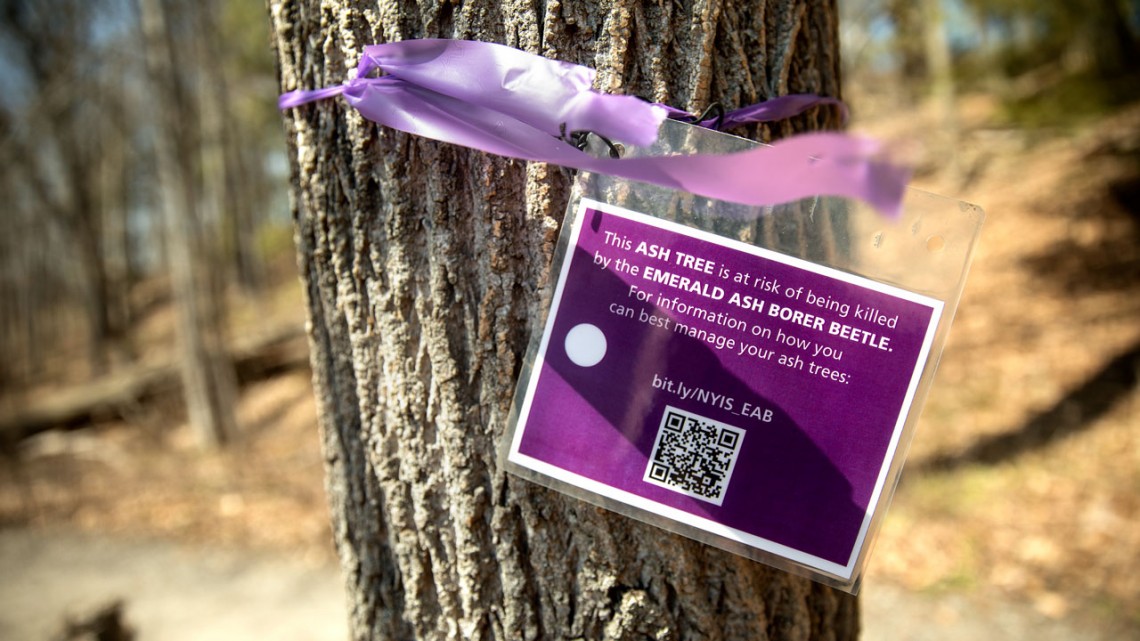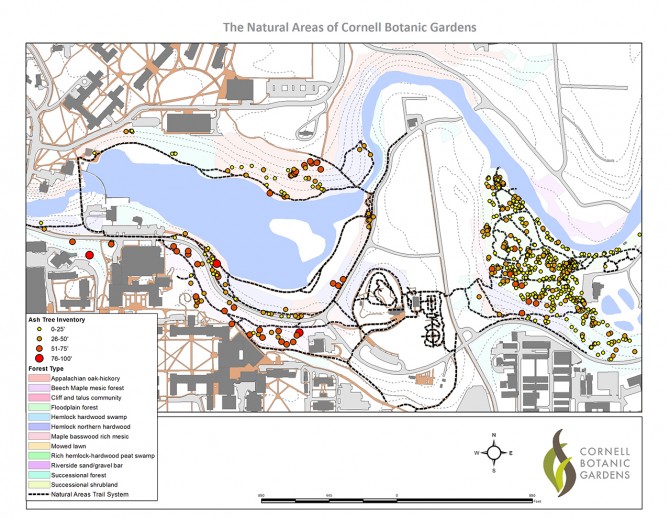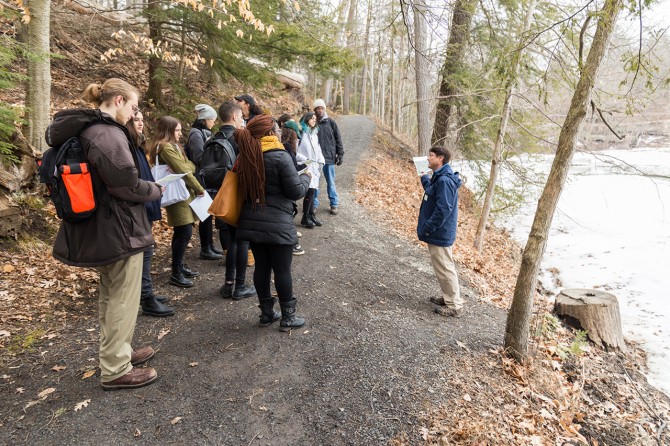
An ash tree near Beebe Lake, marked as part of the site-specific art installation by students in associate professor Gregory Page’s spring 2018 Introduction to Print Media class.
Cornell plans response against emerald ash borer
By Nancy Doolittle
The dreaded emerald ash borer is on the move. Discovered in Cornell’s Arnot Forest in March, evidence of the invasive beetle has been found in downtown Ithaca. Within the next several years, it will change the landscape of campus.
At risk are about 200 ash trees on Central Campus, several of them large, iconic trees. Also under siege will be 43 specimens of ash trees in the Cornell Botanic Gardens’ F.R. Newman Arboretum and thousands more growing in natural areas, including the gorges and wooded areas around Beebe Lake.
The university has mapped its ash trees, and staff at Cornell Botanic Gardens and Facilities and Campus Services are collaborating with faculty and students in entomology, ecology and the arts to prepare for the borer’s arrival. “We are employing a multifaceted approach to the emerald ash borer,” said Mark Whitmore, forest entomologist with the Department of Natural Resources.
Such an approach will determine which individual trees should be saved because of their history, significance or location; and which trees must be removed for safety reasons and their proximity to buildings, roads and pedestrians. In more remote natural areas, where ash comprise 10-30 percent of the trees present, the forest will be changed significantly as trees will be left to succumb to the borer.
Whitmore said that the best defense against the emerald ash borer is planning ahead for the long term and being proactive in managing the damage.
The emerald ash borer creates a significant challenge because of the number of ash trees on Cornell property; the expense of treating individual trees with preventive insecticide every two to three years; and because ash trees become brittle and die quickly once attacked by the borer. Arborists cannot climb an ash tree once the borer is present locally, and many trees on campus are not accessible with equipment, adding to the expense of removal.
“Our foremost concern is safety,” said Todd Bittner, director of natural areas for Cornell Botanic Gardens. “Dead limbs and compromised trees can fall at any time, posing risks to people, vehicles and buildings beneath them as well as to the arborists working with them.” Given the safety concerns and estimated 2,500 ash trees in the campus natural areas, proactive removal of trees will be necessary to mitigate the risk.
Infested trees die quickly once the borer arrives. The borer drills into the layer between the bark and hardwood, riddling the inner bark and choking off the flow of nutrients. Ash trees are inoculated against the borer by injecting insecticide between the outer layer of bark and the inner hardwood or by treating the ground at the base of the tree with insecticide.
Preventive treatments will be used primarily on trees across Central Campus and the collection trees in the Arboretum. “We are not planning to take down any ash trees on the Arts or Ag Quad,” said David Cutter, university landscape architect. “Instead, we will treat these trees to prevent their infestation.” Cutter estimates about 75-80 trees on North Campus, West Campus and Central Campus – from the Veterinary College through Libe Slope and bordered by the two gorge areas – will be treated. “Some of these, such as the sesquicentennial tree on Libe Slope behind the statue of Ezra Cornell, are quite old,” he said.
Untreated ash trees will be replaced by trees and vegetation appropriate for the area, planning for the long-term beauty and ecological health of campus, Cutter said.
According to Rhoda Mauer, director of horticulture at Cornell Botanic Gardens, ash trees in the horticultural collection are being selected for similar preventive treatment based on their genetic significance, hybridization possibilities and potential resistance to the emerald ash borer.
While planning for the immediate threat of the pest, Bittner said Cornell is taking a long-term approach to forest management following the principles of species diversification and promoting the growth of desirable tree species and ground cover.
A site-specific art installation by students in associate professor Gregory Page’s Introduction to Print Media class also helped visualize the challenge. This spring around Beebe Lake, the students marked hemlocks, which are being treated for woolly adelgid infestation, with yellow ribbons and ash trees with purple ribbons, so observers could imagine what that space would look like if those trees were gone.
With help from graduate assistant Gabriel Ramos and Material Practice Facilities printmaking technician Julianne Hunter, the class also created a portfolio of stone and aluminum plate lithography prints to increase public awareness of the destruction posed by the woolly adelgid and emerald ash borer, hoping to develop a constituency to help identify ash borers and thwart their progress.
Media Contact
Get Cornell news delivered right to your inbox.
Subscribe


